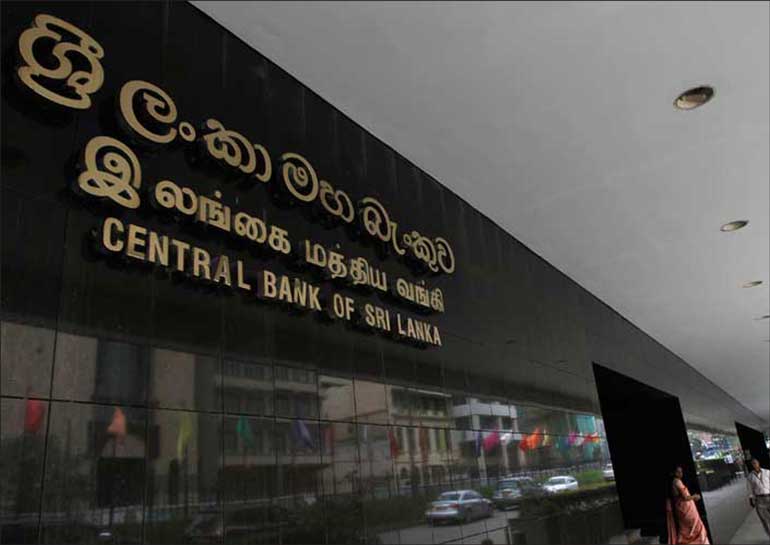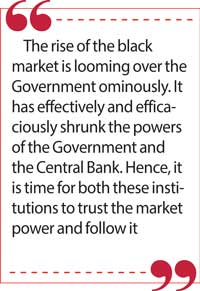Monday Apr 07, 2025
Monday Apr 07, 2025
Monday, 23 August 2021 00:07 - - {{hitsCtrl.values.hits}}

A day will come for the Central Bank to follow the black market and set the exchange rate at that level
 Convenient living in denial
Convenient living in denial
After living in denial of an acute macroeconomic crisis for 19 months, the Central Bank has woken up from its slumber and done the correct thing last week. Its Monetary Board has decided to reverse the loose monetary policy stance it had been following previously by tightening the policy by increasing its policy interest rates by half a percent and the statutory reserve ratio, known as SRR, by 2 percentage points.
Monetary policy tightening: Too short and too late
Though this move is welcome, it is too short and too late. Too short because the present interest rate structure in the system is pretty much below the going inflation as revealed by the price indices compiled by the Department of Census and Statistics. The resultant negative real interest rate discourages savers, while encouraging consumption and borrowings. This had led to an unwarranted increase in the aggregate demand creating a shortfall in the market, spawning inflationary pressures, and raising inflationary expectations. This is bad for the efficacy of central bank’s action.
The Central Bank living in an illusive world
It is too late because this action should have been taken one and a half years ago. Yet, the Central Bank continued to maintain that the Government was adopting an alternative policy, critics of that policy did criticise it due to their not understanding it, and that policy was efficacious in resolving the country’s chronic and acute economic crisis. The Central Bank Annual Report for 2020 has congratulated itself on the success of its policy action. This is what it has said in its opening sentence: “The complex challenges encountered by Sri Lankan economy in 2020 were efficaciously addressed through extraordinary policy interventions by the government and the Central Bank.”
But three months after the release of this report, the Bank has now taken a 180° turn. Justifying the tightening of the policy, the Bank has said, “These decisions were made with a view to addressing the imbalances on the external sector of the economy and to preempt the buildup of any excessive inflationary pressures over the medium term, amidst improved growth prospects.” However, with the outbreak of the fourth wave of the COVID-19 pandemic in July 2021, this optimism of the Central Bank might fade away soon.
Are the policy interventions efficacious?
The efficacious extraordinary policy interventions referred to by the Central Bank in its annual report have been numerous: denting the revenue base of the Government by offering an unsolicited tax package to income taxpayers and VAT payers, accommodating the Government’s voracious demand for funds by buying Treasury bills, and allowing commercial banks to lend the Government and state enterprises excessively, clamping import and exchange controls to resolve the foreign exchange crisis instead of seeking IMF support, shunning the international bond market when the yields on Sri Lanka’s international sovereign bonds or ISBs have risen to historically high levels, seeking to handle inflation not by monetary policy but by introducing a wide range of price controls on main food items, and announcing ad infinitum that its alternative policy works well.
But the reality is different
But the reality has been different. Due to the tax package, the Government had lost some Rs. 519 billion in 2020 compared to 2019 and a similar loss is expected in 2021 too. To fill the gap, the Government had borrowed from the Central Bank and commercial banks during end-2019 and June 2021 a staggering Rs. 2.8 trillion. This has mainly been responsible for the growth in the money stock by 33% during this period by Rs. 2.5 trillion. Since these borrowings have not been sufficient to meet the increased COVID-19 related expenses, the government is now contemplating to request public servants to sacrifice a half of their salaries.
With the dramatic increase in the yields of Sri Lanka’s ISBs, their prices have fallen by about a half. Instead of taking action to resolve this, the Central Bank’s efficacious intervention has been to record the outstanding value of ISBs at the discounted market price and thereby show that the Government’s external borrowings have declined.
Smart data-cooking
This is smart data-cooking, but it is misleading. While it is prudential for a creditor to record his lending portfolio at the discounted market price, a debtor who has the liability to repay the face value should carry it in his books at the face value. The Central Bank has made two other follies here. While it has reduced the outstanding value of ISBs, it has not made the corresponding counter entry. The double entry accounting principles in national accounts require that if the value of the outstanding debt is reduced in this way by a creditor country, the loss must be charged to the budget and be written off.
In the case of a debtor where creditors have agreed to forego a part of their lending, the corresponding entry should be to write back the gain as revenue of the government. But in the present case, Sri Lanka’s creditors have not agreed to reduce the value of debt and therefore the Central Bank has no right to record ISBs at their respective market prices. Its folly in this case is revealed by the fact that when it met the liability on account of the maturing ISBs on 27 July 2021 it paid the full-face value and not the going market price of $ 98 per 100-dollar bond.
The other is the treatment of the ISBs and Sri Lanka Development Bonds or SLDBs held by resident entities. Though the liability is denominated in dollars, the Central Bank has recorded them as Government’s domestic borrowings. The underlying assumption is that there is no foreign exchange outflow on account of these liabilities because they are recycled among the residents. This is true if the country’s foreign exchange situation is in good shape. But with the current shortage of foreign currency, the Central Bank has failed to recycle them in full.
Hence, there is a net outflow of forex, and that outflow is not denominated in rupees but in dollars. Every dollar outflow is a net sacrifice by the nation. Hence, for the Central Bank, it is an illusive and temporary feel-good factor. The other intervention has been the imposition of Import controls and they have not been efficacious in taming the uncontrollable import bill. That is because their application has been on a limited number of consumer goods. As a result, imports have ballooned to a historic level by 30% during the first half of 2021 leaving the trade deficit intact.
Mishap in ancient Rome
A similar mishap was experienced in ancient Rome that led to the eventual collapse of the mighty Roman empire. While there are many scholars who have documented the Roman mishap, a revealing scholarly work has been the work done by Bruce Bartlett, senior fellow with the Texas based National Centre for Policy Analysis.
Bartlett, writing a paper on How Excessive Government Killed Ancient Rome to the 1994 Fall issue of the Cato Journal, has presented an interesting episode of money printing, inflation and the rise of the black economy that led to the eventual fall of the once mighty Roman Empire.
 Release of more coins by debasing them
Release of more coins by debasing them
Roman emperors had been distributing free goods – grain, oil and cotton – to Romans to keep the ordinary folk happy, and thereby preserve their power base. However, when the recipients were more than the producers, the Empire had run into trouble. With lower output, the government’s revenue base had contracted. Instead of resolving that issue, they had continued to debase the currency from high silver content to low silver content, a method of releasing more coins with the same amount of silver and extracting more resources from the people. Thus, its main coin Denarius had 95% silver in 64 CE. By 268, it fell to 5%. Today’s economists call this ‘money printing and imposing an inflation tax on people’.
Unsuccessful price controls
When inflation was rampant, Emperor Diocletian (284-305 CE) introduced a wide range of price controls on almost all the goods and services with penalties as high as death penalty for violators. A contemporary of Diocletian, Lactantius has reported, says Bartlett, that “much blood was shed over small and cheap items and goods disappeared from sale”. But inflation was uncontrollable, and the necessity had forced the emperor to repeal his draconian laws, but not before many had sacrificed their lives.
Yet emperors since then had continued with the debasement of the currency or printing more money in today’s parlance to fill the empty coffers. But all of them had refused to accept that the inflation was the result of currency debasement or printing of more money in today’s context. Instead, like the Sri Lankan political leaders today, they had blamed the greedy merchants for hoarding the goods.
Collapse of the Roman empire
Emperor Julian (360-63 CE), to prove this theory, had released grains from the state’s reserves to the market. But the result he got was totally different. The rich merchants had bought the entire stock, farmers expecting a price increase had withheld their supply, and a thriving black market at which grains were sold at exorbitant prices had developed. But Julian had continued to insist that his policy worked and blamed the complaints of its failure on the ingratitude of the people. By the 5th century CE, the Roman empire fell because it could not pay even the soldiers with debased currency.
Bartlett has attributed it to economic deterioration resulting from excessive government expenditure coupled with high taxation, resultant inflation due to debasing of currency, and over-regulation of the economy through price controls and severe punishments for violators. Though Bartlett has not said it directly, all these three factors had led to the creation of a thriving black economy shrinking the power of the government.
Parallels in Sri Lanka today
Sri Lanka’s present situation is a classic repeat of what happened in Rome some 20 centuries ago. Its Central Bank, having abandoned the accepted monetary theory and flexible inflation targeting, had embraced a new theory called the modern monetary theory or MMT which is now in vogue with irresponsible governments. After expanding the money stock by 33%, leading government figures started claiming that there was no relationship between money and inflation, on one side, and inflation and exchange rate depreciation, on the other.
To prevent the rupee from depreciating against foreign currencies, the Central Bank has kept the exchange rate fixed at Rs. 203 to US dollar. With depleted foreign reserves, the Central Bank is unable to supply dollars to the market to keep this rate fixed. The Central Bank has clamped a partial import and exchange control on selected goods to curtail the import bill. However, the lack of dollars has affected the normal import program too. As a result, a thriving black market has developed for foreign currencies. Normally, the margin in the black market in a normal situation is about 1 to 2 rupees over the official exchange rate. However, in the present case, the margin is as high as Rs. 40, according to reports.
The rise of the black market
According to the Central Bank data, the average weighted deposit rate of commercial banks has stood at 4.77% by August 2021, while new deposits have been contracted at an average of 4.98%. This is in line with the Bank’s low interest rate policy to stimulate investments. However, the national inflation rate is rising at 6%, implying that depositors have been treated to an unfair deal. That unfair deal is the loss of the value of their deposits by about 1% every year due to the negative real interest rates prevailing in the system.
It encourages the public to keep their savings away from formal banking institutions and seek high yields in alternative investments. These alternative investments are speculative in nature promising high quick yields without disclosing the risks involved. They operate in the black economy since some of them are illegal in terms of the law.
Foreign exchange crisis
The present monetary policy tightening has been done by the Central Bank in this background. Though it has reversed its monetary policy, it has not changed its exchange rate policy and the balance of payments policy. But the reality is that the Bank cannot maintain its fixed exchange of Rs. 203 per dollar due to the fast depletion of the foreign reserves. Hence, when there is a shortfall in dollars in the market, the Bank cannot fill the shortfall by releasing forex from its reserves. As a result, commercial banks have been unable to meet the customers’ demand for dollars.
With no sufficient dollar inflows to the country, customers have been requested to remain in a waiting list. As a result, there is a thriving black market operating outside the formal financial institutions. The rate in this market is rising day by day and last week it was reported that it had risen to Rs. 260 per dollar. This is a significantly high premium for dollars in the black market. At that rate, all those who have dollars, including Sri Lanka’s expatriate workers, would turn them to the black market rather than to the formal banking institutions. What this means is that with its fixed exchange rate of Rs. 203 per dollar, the Central Bank has lost its power in the market. A day will come for the Central Bank to follow the black market and set the exchange rate at that level.
Black market has shrunk the power of the Government and the Central Bank
The rise of the black market effectively and efficaciously challenges the power of the Government. This has happened when the Government has introduced maximum retail price for paddy, rice, sugar, and coconuts. Misunderstanding the meaning of a guaranteed price, the Government had asked paddy millers not to buy paddy above the guaranteed price. The result has been the collapse of paddy prices in the market because millers had started buying paddy much below the guaranteed prices. Thus, it is the farmers who have been treated to an unfair deal.
Similarly, rice, sugar, and coconuts are not available in the market at the controlled prices fixed by the Government. These three food items were sold by sellers at the open black market defying the Government’s orders. The control price of coconuts was withdrawn by the Government recently since it could not enforce its regulations effectively. The control prices of rice and sugar remain in the regulatory books but sooner or later, the Government will be forced to withdraw them too.
The rise of the black market is looming over the Government ominously. It has effectively and efficaciously shrunk the powers of the Government and the Central Bank. Hence, it is time for both these institutions to trust the market power and follow it.
(The writer, a former Deputy Governor of the Central Bank of Sri Lanka, can be reached at [email protected].)